Their Majesties King Charles III and Queen Camilla were finally crowned in a service that lasted over two hours and in front of 2,000 guests inside Westminster Abbey, on May 6, 2023.
The event was historic in the sense that only British monarchs have a formal Coronation Ceremony in history. It happened less than 70 years since Queen Elizabeth II was crowned in the same church.
But while the Coronation was steeped in royal tradition, there were parts of the ceremony that were modernized. Except for the Anointing of the Monarch, which was private and was shielded by the screen, other rituals and elements were broadcast live.
However, there were ancient customs that were no longer practiced at King Charles and Queen Camilla's Coronation Ceremony.
1. The Queen Consort did not wear a crown when she traveled from Buckingham Palace to Westminster Abbey.
In previous Coronations, Queen Consort wore the George IV Diadem on the way to Westminster Abbey.
2. No tiaras worn by royals at the Coronation Ceremony. Working female royals just donned a silver flower headdress in addition to their blue regalia.
It looked like wearing crowns that day was exclusively for the King and Queen only. In the past, royals who attended the coronation always had their Coronets or Tiaras.
3. No traditional coronation robes for the King's family and the British Peers. In previous coronations, members of the royal family and British nobles were on their coronation robes and coronets. And there was a part of the ceremony where they had to turn or switch their coronets after the monarch has been crowned.
 |
| Members of the Royal Family |
 |
| The Duchess of Edinburgh and the Princess of Wales |
4. The King's siblings and other working royals wore their Garter regalia instead of coronation robes. The Prince of Wales, The Duke of York, The Duke of Edinburgh, The Duke of Gloucester, and The Duke of Kent were all in their Order of the Garter garments. While The Princess Royal wore her Order of the Thistle regalia (highest honor given in Scotland).
5. Prince Harry, the Duke of Sussex, who is no longer a working royal and who could not wear his military uniform in a public event, wore a simple morning suit.
 |
| Prince Harry in a morning suit seated in the third row without any ceremonial role |
He did not take part in any procession rituals nor paid homage to his father. He was also given a seat on a third row, joining minor royals. An uneventful sight for the son of the crowned King.
6. There was no new crown made for the Queen Consort unlike in the past coronation of the Kings. This time, she re-wore the crown used by Queen Mary in 1911. However, the large diamond in the center called Koh-i-noor was removed and replaced by Cullinan III, IV, and V diamonds, royal jewels that frequently wore by Queen Elizabeth II.
7. Homage of royal blood. Unlike in the previous coronations where royal dukes paid homage to the crowned monarch, only the Archbishop of Canterbury and William, the Prince of Wales did so this time.
 |
| The Prince of Wales knelt before his father to say his vow to be the king's "liege man of life and limb" echoing Prince Philip, Duke of Edinburgh's vow to the Queen in 1953 |
 |
| Prince William paid homage to his father King Charles III |
The Prince of Wales echoed his grandfather, Prince Philip, Duke of Edinburgh's vow to the Queen in 1953 when he made his vow to his father, to be his "liege man of life and limb".
8. One of King Charles III's official titles, Defender of the Faith, which began in the reign of King Henry VIII, granted by Pope Leo X, was refurbished to Defender of Faith to symbolize the multi-religion groups in the United Kingdom and His Majesty's Realm.
9. The ceremony was an hour shorter of Queen Elizabeth II's Coronation in 1953. King Charles's coronation was also scaled down and had only 2,000 guests compared to his mother's coronation with 8,000 invited guests.
10. King Charles III and Queen Camilla's coronation, although full of royal spectacles, was actually less than elaborate compared to previous coronations of British monarchs. They were no jewels that glittered except Their Majesties' respective crowns and coronation symbols.
READ: Full Guide to the Coronation Regalia used and worn by the King and Queen
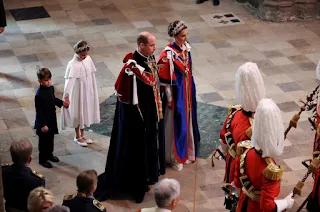 |
| The Prince and Princess of Wales |
 |
| Nieces of the King. Zara Tindall, Lady Louise, Princess Eugenie and Princess Beatrice |
The ceremony was scaled down due to the rising cost of living in the United Kingdom so royal guests and members of the royal family were told not to wear elaborate robes and tiaras and just wore hats and their best Sunday outfits.
READ Related story: Charles III: The Crowning of the Modern King
Nonetheless, royal spectacles of horse-drawn carriages, bright livery donned by royal staff, and a military parade were seen during the celebration.
Not seen on the streets of London for 70 years, the Coronation Procession has made its way from Westminster Abbey to Buckingham Palace.
Representing the diversity and traditions of the UK and Commonwealth Armed Forces, over 4,000 personnel took part in this spectacular display of pageantry, and some 250 horses.
The newly Crowned King and Queen traveled in the historic Gold State Coach, which has been used at every Coronation since that of King William IV in 1831.
Photos credit: The Royal Family

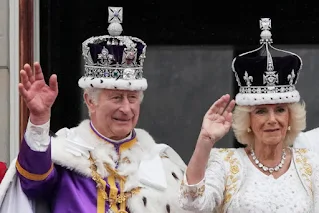
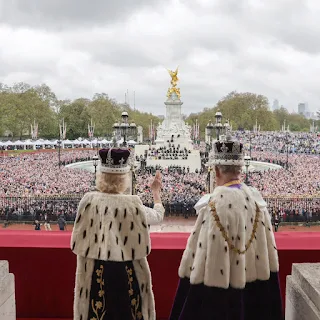



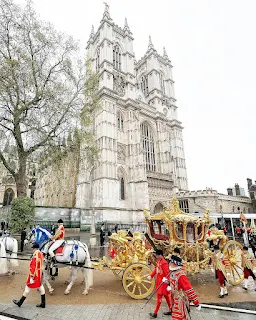
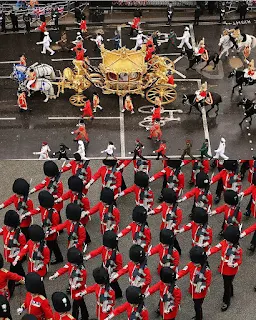







0 Comments